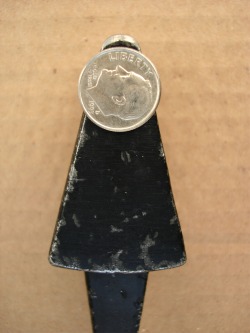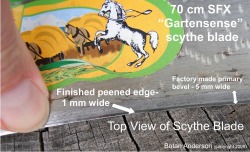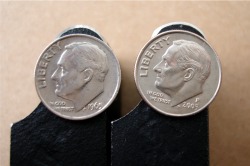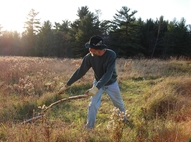 A narrow, or bar peen anvil, needs to have a rounded face. How rounded should it be? Preferences vary with peening techniques. The amount of roundedness is called the radius. Since all rounded narrow anvils are rounded off by hand (not cast), it's an approximation that can vary slightly between individual anvils, and considerably with entire batches from year to year. The amount of radius makes a huge difference in how the anvils peens, yet no one that sells scythe anvils ever describes it. I've been trying for years to think of a way of classifying the amount of radius on a narrow anvil. Measuring the radius in actual mm is hard to relate to unless you're an engineer. Also, I don't have a metric radius gauge, and haven't come up with one yet. Classifying the radius as narrow, medium, or wide seemed too vague and relative, without a method of measurement. So I thought of comparing the radius to a common standard sized object. The best thing that I could think of was a U.S. dime, which has a radius of 9mm. According to engineer Gerhard Wagner of the SFX factory, a radius of 9-12mm on a narrow anvil is classified as a "blunt" anvil. 6-8mm is a "normal" anvil, and 4-5mm is a "sharp" anvil. The Picard anvil pictured above, looks like it has a radius at the narrower side of the "normal" spectrum. The commonly available Czech-made "babbka's", are not rounded, but they are soft enough to shape a radius to your liking. Good luck doing that with the Picard, or the 60 Rockwell SFX anvil!  It recently occurred to me that a more practical way to describe the radius of an anvil, might be to just describe how wide a line you create when peening with the anvil. A wider or "blunt" radius would make a wider (2 - 2.5mm), more tapered line, A medium or "normal" radius would make 1 -1.5mm, and a narrow or "sharp" anvil would peen a very narrow line (0.5-1mm). So on my ordering page I describe approximately how wide a line an anvil peens, using my peening technique. If you strike harder or softer with the peening hammer, you may get somewhat different results.  Pictured on the left is the radius of a 10cm high SFX anvil that I have right now, and on the right, the radius of the 16cm tall SFX anvil. As you can see the tall anvil has a slightly bigger radius as the dime (maybe 10mm), which would be classified as a "blunt" anvil. All the SFX anvils available before 2009, had a blunt radius, and no guide plate. Last year Ernst changed the radius of the SFX anvils to a medium or "normal" radius, and added a guide plate. Peter Vido's style of free-hand peening, where you start several rows in, and work your way out with successive passes, is much easier to do with a "blunt" anvil. The wide radius makes it easy to draw the metal out smoothly, without creating deep grooves. A more tapered primary bevel will take longer to peen, but it's especially good for grass blades. You can definitely create an edge thin enough to "run under the nail", as clearly demonstrated in the video below by my friend Neil Dudman at Kosimezsnado. An edge this thin will be more vulnerable to denting, and even cracking, if you hit a rock or a woody stem. My fields here are pretty rugged, so I prefer a less tapered primary bevel and a 1mm cutting edge, or Dangel.
The narrower "normal" radius works better with Bernhard Lehnert's method (especially with the guide plate), where you stay at the edge, and work it out with repeated passes. The method that I explain in my peening manual is based on Lehnert's technique described in his book on peening called Dengeln. The new SFX anvils with the narrower radius and the guide plate, work very well with Lehnert's method. This method is much easier for beginners to learn and get a good start in mastering the art of peening.
2 Comments
Your comment will be posted after it is approved.
Leave a Reply. |
Botan AndersonArchives
March 2023
Categories
All
|

 RSS Feed
RSS Feed